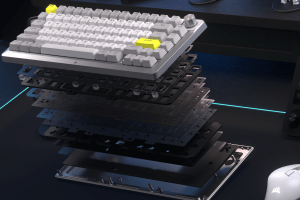## Pocket Powerhouse Upgrade: MSI’s Claw Claws Back with AMD
Remember the MSI Claw? That sleek, Android-powered gaming handheld that promised PC-like performance on the go? Well, get ready for round two, because MSI’s back with a souped-up version, ditching its previous chipset for the raw power of AMD. That’s right, folks, we’re talking serious performance in a seriously portable package.

Display and Controls: A Deep Dive into the Claw’s Hardware

MSI’s Claw handheld gaming PC boasts a robust hardware configuration designed to deliver a powerful mobile gaming experience. At the heart of this power lies a 7-inch 1920×1200 IPS LCD display, offering sharp visuals and vibrant colors. The display’s 120Hz refresh rate promises smooth and responsive gameplay, minimizing motion blur and enhancing the overall fluidity of the experience.
Complementing the impressive display are the Claw’s robust controls. The handheld features a full complement of physical buttons, including shoulder triggers, bumpers, joysticks, and face buttons. These controls are designed for precision and responsiveness, ensuring gamers can execute complex maneuvers and enjoy a comfortable and immersive gaming experience. Gamestanza anticipates these controls will feel remarkably similar to a traditional gamepad, a crucial factor for handheld PC gaming success.
One particularly noteworthy feature is the inclusion of Hall effect joysticks. Unlike traditional resistive joysticks, Hall effect joysticks utilize magnetic fields to detect movement, resulting in greater durability and accuracy. This technology promises to enhance the longevity and responsiveness of the Claw’s control scheme, a welcome addition for serious mobile gamers.

Battery Life and Portability: Can the Claw Keep Up With the Demands of Mobile Gaming?
The Claw’s portability is a key consideration for gamers on the go. MSI has equipped the handheld with a 40Wh battery, which, while not class-leading, should provide a respectable amount of playtime. However, the actual battery life will vary significantly depending on the game being played and the device’s performance settings.
Gamestanza believes the Claw’s battery life will likely fall somewhere within the 3-5 hour range for demanding titles and could stretch to 6-8 hours for less graphically intensive games. This is comparable to other high-performance handheld PCs on the market.
The Claw’s weight and dimensions are also important factors for portability. At approximately 600 grams and 269 x 133 x 39.5mm, it’s relatively compact and lightweight for a handheld gaming PC.
Gamestanza anticipates the Claw’s portability will make it a suitable device for travel, commuting, and casual gaming sessions.
Software and Customization: Does the Claw Offer Gamers the Control They Crave?
MSI has implemented a user-friendly software interface on the Claw, providing gamers with a level of customization and control.
Game Stream & Controls
Gamestanza expects the Claw will leverage MSI’s Game Stream technology, allowing users to seamlessly stream games from their PC to the handheld device. This feature opens up a vast library of PC games for mobile play.
Performance Tuning & Optimization
Gamers will likely have the ability to adjust various performance settings, including graphics quality, frame rate, and CPU/GPU clock speeds, to optimize the gaming experience based on their preferences and hardware capabilities.
The Claw’s software should also offer customizable control schemes, allowing gamers to map buttons and adjust sensitivity to personalize their gameplay experience.
The Future of Handheld Gaming: A New Era of Choice?
The introduction of MSI’s Claw handheld gaming PC represents a significant development in the rapidly evolving world of handheld gaming. By opting for AMD’s latest processors and graphics, MSI is directly challenging the dominance of Valve’s Steam Deck, offering gamers a compelling alternative with its own unique strengths.
Potential Implications for Steam Deck and Other Handhelds
The Claw’s arrival is likely to intensify competition within the handheld gaming market. Valve, the creator of the Steam Deck, has established a strong foothold in this space, but the Claw’s powerful hardware and innovative features could attract a new wave of users seeking a more versatile and high-performance handheld gaming experience.
Gamestanza believes this increased competition will ultimately benefit consumers by driving innovation and pushing the boundaries of what’s possible in handheld gaming. It will be interesting to see how Valve responds to the Claw’s challenge, potentially leading to further refinements and improvements to the Steam Deck.
Addressing the Competition: How Does the Claw Differentiate Itself in a Crowded Market?
MSI’s Claw distinguishes itself from the competition through several key factors:
- AMD Hardware: The Claw’s use of AMD’s latest processors and graphics promises a significant performance boost over some existing handheld competitors.
- Hall Effect Joysticks: These joysticks offer enhanced durability and accuracy, crucial for demanding gaming genres.
- Software Customization: MSI’s software interface appears to offer a high degree of customization, allowing gamers to tailor the Claw to their preferences.
- Game Streaming Capabilities: The potential for seamless game streaming from a PC expands the Claw’s game library considerably.
Looking Ahead: What’s Next for MSI and the Handheld Gaming Scene?
The launch of the Claw marks an ambitious entry into the handheld gaming market for MSI. Gamestanza anticipates that the company will continue to invest in this area, potentially releasing future iterations of the Claw with even more advanced hardware and features.
The handheld gaming scene is poised for significant growth in the coming years, with more players seeking portable and versatile gaming experiences. MSI’s Claw has the potential to become a major player in this space, driving innovation and expanding the possibilities for mobile gaming.
Conclusion
MSI’s bold move to swap Intel’s processors for AMD’s in their new Claw gaming handheld is a fascinating development in the portable gaming landscape. The article highlights the potential performance gains this switch could bring, leveraging AMD’s Ryzen Z1 processors known for their power and efficiency.
This shift signifies a potential turning point for the handheld gaming market, where competition between AMD and Intel will likely become more heated. It also raises intriguing questions about the future of handheld gaming. Will this be the catalyst for a new wave of powerful and affordable portable consoles? Will we see more manufacturers follow suit, embracing AMD’s technology for their handheld devices? Only time will tell, but one thing is clear: MSI’s Claw has set the stage for a thrilling new chapter in portable gaming, one where raw power and accessibility go hand in hand. This isn’t just about crunching numbers; it’s about pushing the boundaries of where and how we experience gaming.
The future of gaming is mobile, and the battle for that future has just gotten a whole lot more exciting.